

trans magazin, true to its grammatical form, is a journal of multiple cross-disciplinary perspectives on architectural and urban issues. An independent student cohort from the Department of Architecture at the Swiss Federal Institute of Technology ETHZ manages the editorial, publishing twice a year since 1997.
The subject of our Screen/Print feature is trans’ most recent issue, “Lust”. A scabbed, slightly hairy knee graces the magazine’s cover – a charmingly nasty suggestion that what’s inside might not be what you’d expect between the glossy sheets. The selected piece for Screen/Print, “Satellites of Love” by writer and researcher Alexis Kalagas, looks at how the pursuit of love is mapped out in urban spaces, both online and off. "Lust" is available in both English and German.
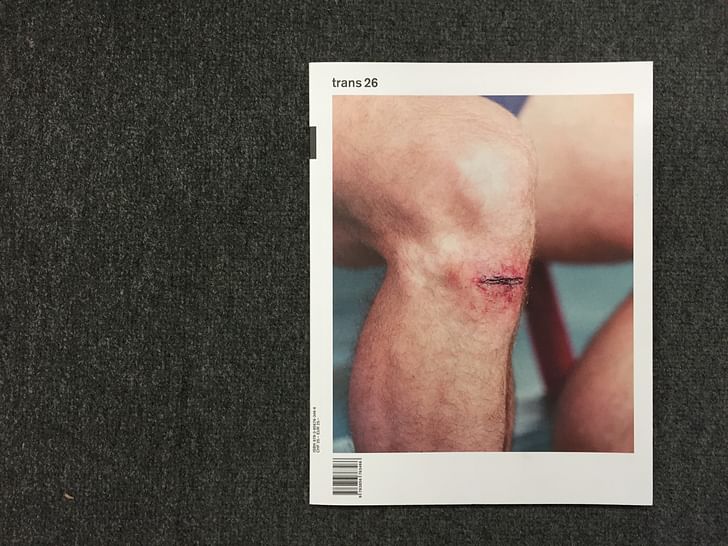


Satellites of Love
by Alexis Kalagas
Bloomingdales amidst the last-minute Christmas rush. A man and woman reach for the same pair of black cashmere gloves. Perfect strangers, the chance encounter between John Cusack and Kate Beckinsdale in a department store accessories aisle is Serendipity’s meet‑cute opening. Harking back to Hollywood’s screwball golden age, the "meet-cute" is a sub-trope of the classic "boy meets girl". A contrived plot device to bring two characters together and speed them towards a feel‑good romantic climax. With the twin towers digitally erased before its post‑9/11 release, Serendipity endures more as a sickly sweet millennial the metropolis as a landscape of urban adventure (sexual possibility) and predation (sexual danger).curiosity than holiday classic. But in its blatant attempt to reverse engineer the romantic comedy canon, the film buys into a "what if" fantasy of true love where fate has the power to transcend the unsentimental randomness of everyday life.
Three years later, a group of software engineers at MIT’s Media Lab unveiled a less starry-eyed plan to take the "chance out of the chance encounter". "Serendipity" was an early mobile trial that sought to combine an emerging Bluetooth connectivity and a database of personal profiles to orchestrate face‑to‑face contact between nearby users. This application of "social proximity sensing software" was itself a more sophisticated but chaste update on the Lovegety – a beeping, flashing, pocket matchmaking device from the brains behind Tamagotchi, which caused a short-lived sensation on the streets of late 1990s Tokyo. Like its cinematic namesake, Serendipity grew from the idea that social interaction in large-scale spaces of congregation – cities – is in theory limitless, but in practice bounded. A sea of unknown people surrounds us, but routine shapes our social lives.

Urban sociologists have long explored this disconnect – the city as a world of strangers marked by the paradoxical presence of closeness and distance. Lehtonen and Mäenpää have described a culture of "street sociability" arising from the resulting tension between anonymity and intimacy [1]. For Bech, this tension manifests as a full-blooded, "omnipresent sexualization", with much of what we understand as modern sexuality only possible within the pulsing life spaces of the city[2]. And movement through this world has an eroticized edge. The flaneur is the prototypical figure in urban studies. But the literal streetwalker is a prostitute soliciting in the streets, while the notion of ‘cruising’ the urban terrain masks an unstated sexual intent. Popular narratives of the city have reflected this dualism – the metropolis as a landscape of urban adventure (sexual possibility) and predation (sexual danger).
Cities also form the backdrop of the modern "mating market". Auden dismissed the sex drive as "an intolerable neural itch" [3]. But strip away the chemical circuitry fuelling lust and attraction, and population and proximity offer an abundance in supply, opportunity, and freedom. At the same time, research into how people actually find partners – the "search" problem of mate selection – suggests the idealized serendipitous encounter is a mass delusion. The vast majority of couples don’t "meet‑cute". While Giddens wrote breathlessly of a radical "transformation of intimacy" shaped by urbanization, feminism, and a new "plastic" sexuality driven by the pursuit of pleasure over procreation, the initial sparks of it's the geeks who have remade the world in their own image.real world romance are sadly more mundane[4]. Around 65 percent of heterosexual couples meet the old-fashioned way – through friends, family, co‑workers, or classmates[5]. The modern city may be a sexual smorgasbord, but most adults have distinctly unadventurous tastes.
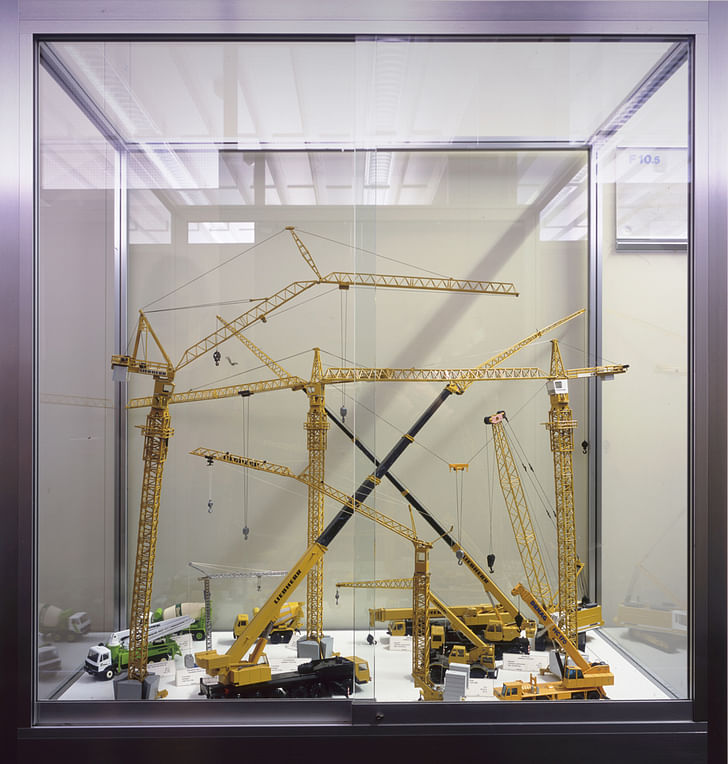
Ironically then, it's the geeks who have remade the world in their own image. The online dating industry, which grew out of the empowering anonymity and geographic emancipation of the earliest internet chat rooms, has embraced the beauty of the search algorithm and run with it to the tune of $2 billion. When other forms of web-based introductions are added to the mix, almost one-quarter of American couples now make first contact online[6]. The virtual arena that only emerged as recently as 1995, with the launch of Match.com, has already displaced the social role of traditional meeting grounds like bars and cafes. In fact, it’s on a The modern city may be a sexual smorgasbord, but most adults have distinctly unadventurous tastes.growth trajectory that could eventually see it eclipse even the influence of intimate social networks. While proximity still matters (for now) when it comes to "offline" consummation, the internet has flattened the romantic landscape.
Yet even as they reproduce and multiply to cater to the most niche desires, traditional online dating platforms have been criticized as embodying a broader shift towards insular technologies of separation, which encourage a retreat from public space and the physicality of urban relations. Price famously asked "technology is the answer, but what was the question?" In part, his unbuilt Fun Palace was a radical proposal to throw open this loop, including plans to integrate cutting edge communications technologies of the era "in the hopes of an eruption or explosion of unimagined sociality through pleasure"[7]. Architects and designers continue to grapple with the social and interactive possibilities of material structures. In the meantime, the ubiquity and non-stop evolution of handheld mobile devices has projected the pleasure principle to the city writ large, establishing an elusive bridge between the digital and physical worlds.
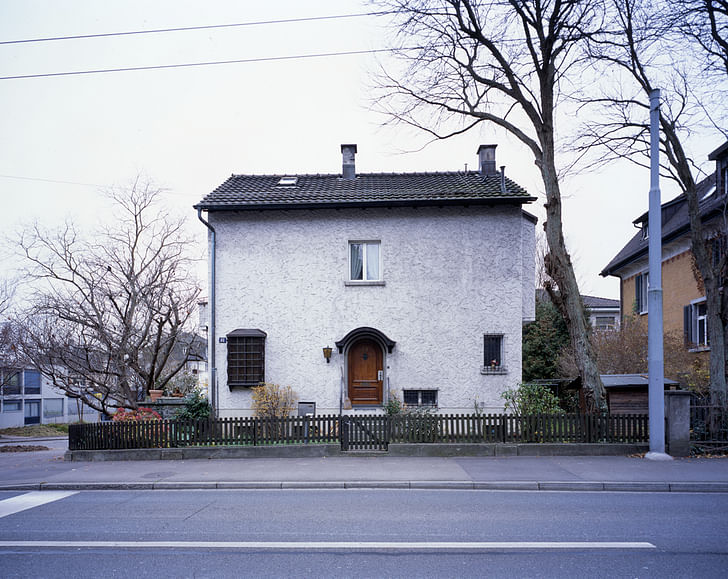
In the age of apps, this kind of "mixed-mode" functionality represents the Holy Grail. By harnessing four of the most on point Silicon Valley touchstones – social discovery, location, gamification, and messaging – alongside the enticing promise of instant gratification, Tinder has become an international phenomenon. Launched in September 2012 by the Los Angeles-based incubator Hatch Labs, Tinder is intentionally simple. A minimalist, image-heavy profile is generated by tapping into a user’s Facebook account, which also works as a form of social authentication. Gender and age preferences, as well as a geographic search radius, can be adjusted at will. From then on, it’s a case of swiping left (No Thanks) or right (I’m Interested) as a cascade of romantic possibilities appear. If both people swipe right, they are "matched" and can message each other. No time-intensive questionnaires, no "perfect match" compatibility formulas.
the ubiquity and non-stop evolution of handheld mobile devices has projected the pleasure principle to the city writ large, establishing an elusive bridge between the digital and physical worlds.Tinder’s rough and ready approach to online dating has proven to be a heady mix. In only two years it has accumulated almost 50 million active users, now processes a staggering one billion left and right swipes daily, and matches 14 million prospective couples every 24 hours. Beyond the huge and rapidly growing dating pool, what’s most eye-opening is how these users actually engage with the app. According to the company, people log into Tinder around 11 times per day and spend an average of 90 minutes per day "Tindering". Speak to any new user furtively checking their notifications or compulsively swiping profiles, and it’s hard to ignore the app’s intensely addictive properties, or "stickiness". Tinder’s genius is in transforming romance and seduction into a palm-piloted game, with the dopamine drip of ego boosting matches and lure of on-tap virtual voyeurism emerging as ends in themselves.
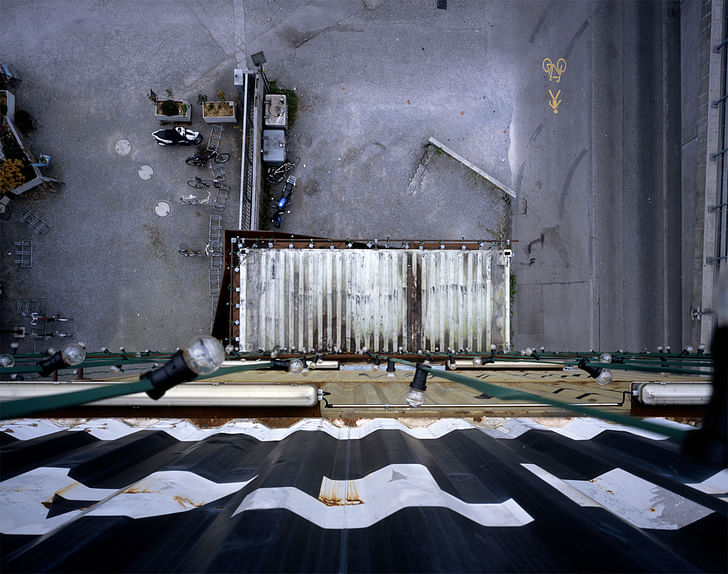
Yet by remaking urban sexuality as a frictionless spatial game, Tinder is also expanding the boundaries of social interaction in the city. In the same way as other "people nearby" apps like the hyper specific libido blast of Grindr, the combination of mobile device as bodily appendage and GPS beacon has introduced a new way of navigating space and social encounter. Whether used to satiate the lustfulness of the everyday, or burst free from the gravitational pull of established social orbits, Tinder mediates not only the digital relationships between users, but also their experience of physical space. By rerouting digital networks in real-time, the app overcomes the geographic proximity barrier in urban sociality, as well as collapses perceptions of intimacy and distance. While inherently "urban" in its reliance on a city’s possibility for encounter, it transforms what it means to inhabit an urban world of strangers.
Sometimes this reality comes as a shock. In the throes of an all-in Tinder honeymoon period, a friend walked into a local bar with a recent match only to hastily usher her out after glimpsing his previous night’s date across the room. New connections play out in an online setting where user proximity is tracked endlessly by an array of highly-calibrated satellites. But back on earth it’s easy to forget these abstract spatial routines overlay in an interlocking urban web. At other times, that’s the whole point. As Tinder extends its global reach, travellers are using the app to immediately plug into the social lives of foreign cities. Touch down, log-in, Touch down, log-in, swipe right.swipe right. This international dimension is so popular that a key element of Tinder’s monetization strategy is a new "Passport" feature allowing paid-up premium users to start searching beyond the usual geographic limits prior to arrival.

More territory means more choice. And Tinder was already a "floating supermarket" of prospective lovers, spiked with the easy high of instant validation. Upon finding their attraction reciprocated, users are presented with the option to either start chatting or "Keep Playing". If Tinder is a game, it’s a game that trades in the accumulation of ever more matches. While that may bring our cities closer to Price’s "explosion of unimagined sociality", for those seeking more meaningful connections it’s a fraught path. There are neurological limits on humans’ ability to process information, and the task of having to choose is often experienced as suffering, not pleasure[8]. People like the idea of choice, but overestimate their capacity to manage it. The brave new world of Tinder doesn’t just perpetuate the distinctly urban idea that there’s always someone better around the corner, but promises a tantalizing digital shortcut.
it was no accident that programmers reached for an architectural vernacular.Technology has already dramatically affected how we approach sex and intimacy. These are primal impulses alive in a "liquid love" information age[9]. Alarmist outcries lamenting the rise of a "hookup culture" are nothing more than misguided generational moral posturing. But Tinder does make easy a form of no-strings-attached, episodic sexuality. While coupling begins online, even transactional encounters are ultimately shaped by physical space. Proximity equals convenience, and casting the Tinder net wider and wider is usually a sign of diminishing returns. Looking ahead though, the future may be very different. "Red Light Center" is a growing online "metaverse" that functions as an anything‑goes adult playground for avatar-enacted cyber sex. Emerging "teledildonic" devices allow for distant partners to engage in synthetic sex by remote control. Even condom-maker Durex is trialing "fundawear" – a vibrating underwear prototype controlled by a smartphone app.

it’s ultimately a 21st century spin on the notion that sexual potential is firmly embedded in the fabric of urban lifeVirtual sex worlds. Remote sex. Robot sex. The lascivious flaneur of the future may stalk an entirely de‑spatialized terrain. But for now, Tinder represents a welcome technological advance that strengthens, rather than undermines, experiences of urban interaction. Whether arriving solo in a new city or feeling the slow creep of social claustrophobia, the app reshapes the "rules" of urban behavior by harnessing the digital realm as a safe staging ground for in the flesh encounters. While this is at odds with the romantic dreams of spontaneous love peddled by Hollywood, it’s ultimately a 21st century spin on the notion that sexual potential is firmly embedded in the fabric of urban life. When the first chat "rooms" emerged, it was no accident that programmers reached for an architectural vernacular. Nostalgia or not, our digital desires find meaning in life beyond the screen.

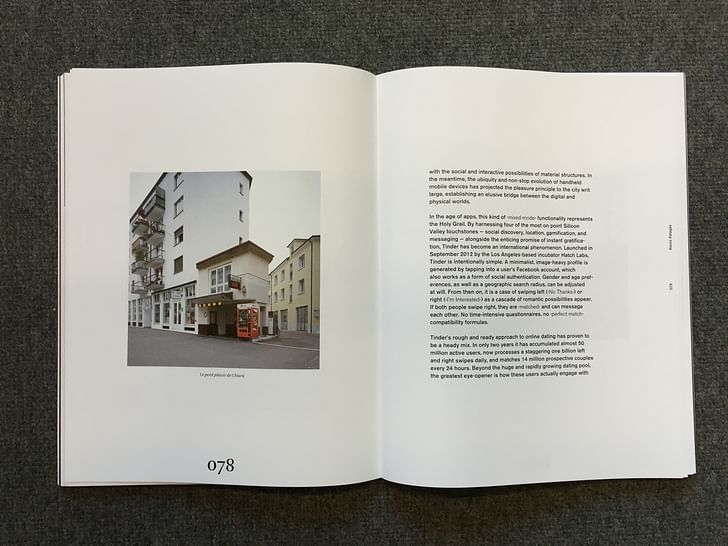

About the author, courtesy of trans:
Alexis Kalagas (1982) is a writer and researcher at the Urban-Think Tank Chair of Architecture and Urban Design at ETH Zürich. He completed graduate studies in Geneva and Boston, where his research centered on the spatial dimensions of urban violence, and holds degrees in arts and law from the University of Melbourne. With previous experience as a foreign policy advisor and the editor of a Geneva-based media start-up, he was the guest editor of the most recent issue of SLUM Lab magazine, and is currently working on a book exploring a post-crisis vision for Athens.
Editors: Samuel Aebersold, Sören Davy, Ferdinand Pappenheim, Lex Schaul
Other contributors to "Lust" include:
Christina Albert, Pier Vittorio Aureli, Bozarthfornell Architects, Mary Casper, Roxanne de Raeymaecker, Kathrin Dörfler, Andrea Alberto Dutto, Sebastian Ernst, Pascal Flammer, Anna Heringer, Ludger Hovestadt, Johnston Marklee Architects, Alexis Kalagas, Bettina Köhler, Annette Kurz, Torsten Lange, Camille Lichtenstern, Niels Lehmann, Claire Lin, Bernhard Malkmus, Jürgen Mayer H., Peter Märkli, Marija Maric, Metaxia Markaki, Jacqueline Maurer, Vasiliki Nikoloutsou, Isavella Oikonomopoulou, Lilian Pala, Luka Piskorec, Klaus Platzgummer, Christoph Rauhut, Michal Switalski, Francesco Tonnarelli, Philip Ursprung, Tobias Wootton und das Seminar Architektur und Fotografie, Patrick Zamojski.
Screen/Print is an experiment in translation across media, featuring a close-up digital look at printed architectural writing. Divorcing content from the physical page, the series lends a new perspective to nuanced architectural thought.
For this issue, we featured trans.
Do you run an architectural publication? If you’d like to submit a piece of writing to Screen/Print, please send us a message.
Former Managing Editor and Podcast Co-Producer for Archinect. I write, go to the movies, walk around and listen to the radio. My interests revolve around cognitive urban theory, psycholinguistics and food.Currently freelancing. Be in touch through longhyphen@gmail.com
No Comments
Block this user
Are you sure you want to block this user and hide all related comments throughout the site?
Archinect
This is your first comment on Archinect. Your comment will be visible once approved.